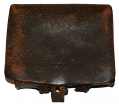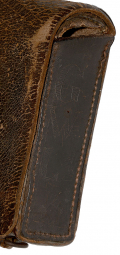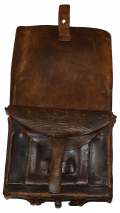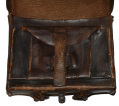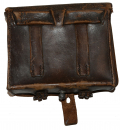site search
online catalog
CONFEDERATE CARTRIDGE BOX OF GEORGE WASHINGTON LITTON 29th VIRGINIA, CAPTURED AT DINWIDDIE COURTHOUSE/FIVE FORKS, DIED AS P.O.W. MAY 1865
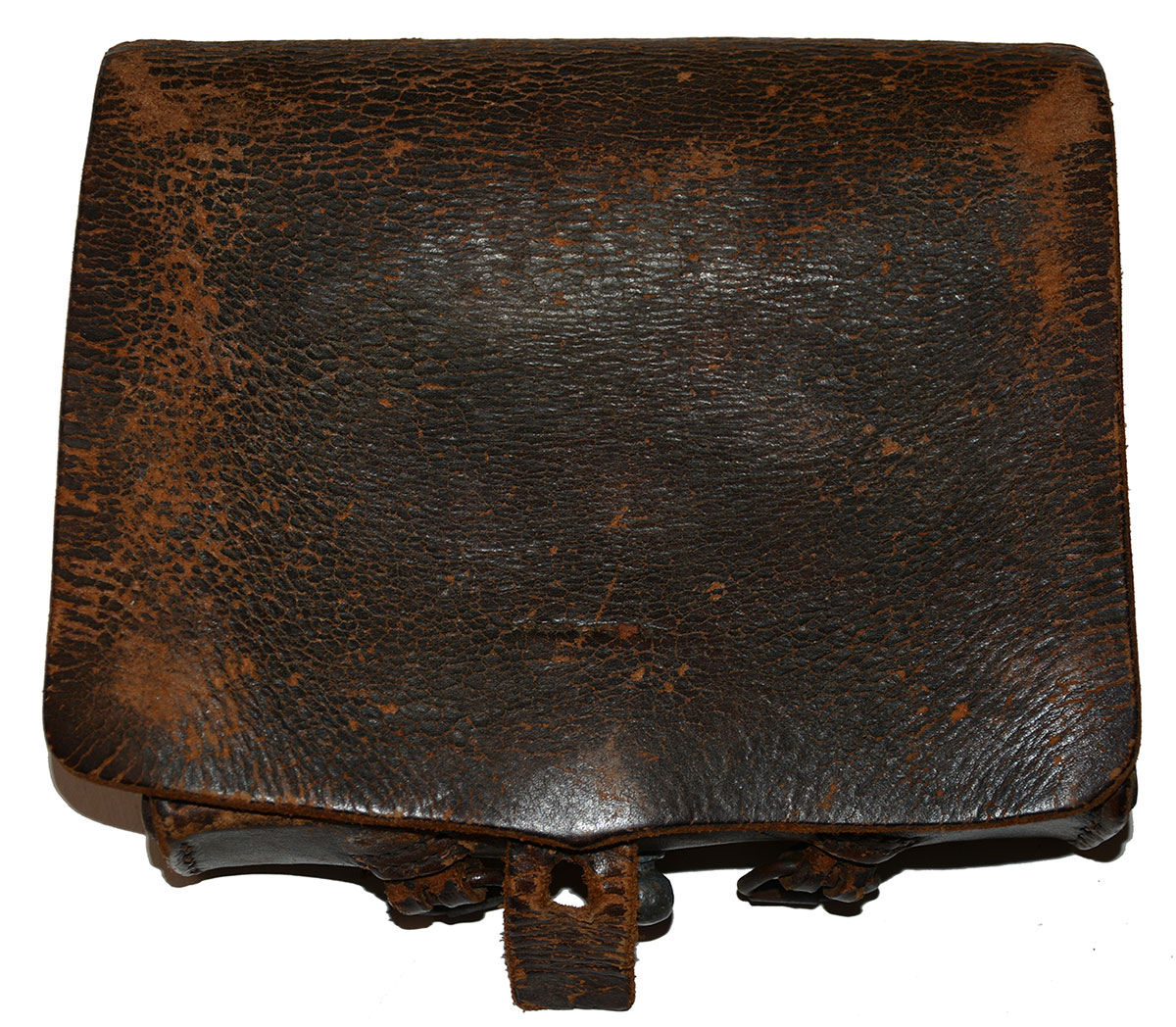
$3,500.00 ON HOLD
Quantity Available: 1
Item Code: 1179-627
This Confederate-made cartridge box follows the general lines of the U.S. 1857 pattern, is clearly inscribed by the Confederate soldier, is in excellent condition, must have made a wonderful war souvenir for its Union captor, and is a tangible relic of a Confederate soldier who served at least from 1862 to 1865, was captured in one of the last battles of the war, and died before he could return home to his wife and six children.
The box is brown leather, with loops on the back for both a shoulder sling and a waist belt. The waist belt loops are squared off at the bottom (rather than neatly rounded, like its Federal counterparts,) and are sewn only. The horizontal loops are formed by a strip passing through the back of the box at center, like the US pattern. There are two small roller buckles are sewn to the bottom of the box to fasten a shoulder sling. The latch tab finial is pewter (or lead) and round. The latch tab is intact and in place, secured by a single line of stitching. The flap has only very slightly rounded corners and is straight along the bottom giving it a very squarish look. The finish on the back of the box is very good. The finish on the outer flap is good, showing some crazing and fine wrinkling, with some wear spots at the upper corners and along the left edge (as looking at it) from flexing and use in the field.
The box also follows the US pattern in having an inner flap with attached side ears, showing wear, but present, and an implement pouch with its own flap and closure tab. The finish of the inner flap shows wrinkling, but only minor rubs. The long tab for the implement pouch is solid and complete, but shows wear and rubbing. The edges of the implement pouch and the front side and bottom edges of the box show wear to the finish. There are no magazine tins- frequently missing from US and CS boxes alike. The seams are all good. We note just one stitch missing at the upper front left of the box.
Along the upper front of the box, just above the implement pouch, is neatly scratched in is: “G. W. LITTON 29 Rg RUSSELL.” There may be something following “Russell,” but if so, it is too light to make out (we would guess “Co.” or “Va.” if anything,) but the inscription is unambiguous. George Washington Litton was born in Russell County, VA, 11 October 1829, one of five children of Solomon and Judith Litton. We find him working on his parents’ farm in 1850. He married in 1853 and the 1860 census picks him up in Russell County as a farmer, with his wife and four children, with Lebanon as a post office. (They had two more children in 1863 or 1864, so he apparently got home on leave from the army occasionally.)
He is listed as a member of Russell County’s militia regiment: the 72nd Virginia Militia, and as having joined the 29th Virginia Volunteers, mustering into Co. G as a private 27 March 1862. The 72nd Militia is recorded as mustering in March 20, so it is unclear if Litton’s service in that unit dates only from that point, with a transfer a week later (or merging of that unit into the 29th) or, as likely, he had been a member of the militia unit for some time. In any case, he received a bounty of $50 for “re-enlisting’ when he joined the 29th. The 29th had been authorized in November 1861, but never had more than five companies, one of which was from Russell County. At its reorganization for “three years or the war” in Spring 1862, it got three more companies, including Litton’s company from Russell County, and the unit shifted some men around to form nine in total. Enlisting in the same company with George Litton was his older brother, Andrew Jackson Litton, who died of fever in August 1864 at Richmond’s Chimborazo Hospital. (The family liked Presidential names: they had a cousin, Zachary Taylor Litton.)
The regiment was initially assigned to southwestern Virginia and served at Wolf Creek and Princeton. In December 1862 it joined Colston’s Brigade, Dept. of NC and Southern Virginia, and in April and May took part in Longstreet’s Suffolk Campaign, seeing action at Edenton Road, and joining Corse’s Brigade of Pickett’s Division in May. They were on detached duty for Chancellorsville and Gettysburg, and then went west to Tennessee, taking part in the siege of Knoxville. In early 1864 they were back in North Carolina, fighting at Plymouth, before moving back to Virginia for the Petersburg and Richmond Campaign, fighting on both the north and south side of the James, seeing action at Drewry’s Bluff, the North Anna, Cold Harbor, and the siege of Petersburg.
Existing muster rolls show Litton present every time, with the exception of a note on the 2/28/1864 roll stating he had been absent sick in the hospital on the last payday. CWData lists more than a hundred points at which the regiment took casualties of some sort, during its service, mostly small but continual losses until the Petersburg campaign when they suffer larger losses in individual engagements at Drewry’s Bluff (May 14-16,) Cold Harbor (6/1 and 6/3,) along with steady smaller losses along the Howlett Line and other entrenchments.
Litton was taken prisoner on April 1, 1865. His place of capture is given as Dinwiddie Courthouse, though that was technically fought March 31 and the April 1 fighting was just north of there, at Five Forks. (Almost all the regiment’s listed casualties for those days are simply said to have been at Dinwiddie.) Both battles resulted from Grant stretching his lines west at the end of March, threatening the last communication and supply lines out of Petersburg. Pickett, along with Fitzhugh Lee, was tasked with countering that threat and Litton’s regiment was in one of six brigades arriving at Five Forks on March 30. They pushed south and had some success in pushing south and forcing Federal forces back toward Dinwiddie Courthouse on March 31, pulled back to Five Forks early on April 1 and began throwing up entrenchments. Sheridan launched a series of assaults that won the day, with Corse’s brigade noted as among the forces trying to hold the line toward the end of the fighting. The fall of Petersburg followed and Appomattox was less than a week away. Pickett’s reputation never recovered from having been absent, with some other officers, at a fish bake when Sheridan struck his troops.
Litton was among the many captured in the debacle. He was sent to City Point and then on to prison on Hart’s Island in NY Harbor on April 7. There he developed Typhoid, dying May 23. A memorial stone stands in the Solomon Litton Hollow Cemetery in Russell County, VA, where his brother and other family members are buried, but his actual headstone is in the Cyprus Hills National Cemetery. His wife survived to 1881.
This is a wonderful example of a Confederate-made cartridge box, following the general lines of the M1857, but showing a little cruder work and haste in construction, but still very well done, and is great combination of condition and history. [sr] [ph:L]
~~~~~~~~~~~~~~~~~~~~~~~~~~~~~~~~~~~
THIS ITEM, AS WITH ALL OTHER ITEMS AVAILABLE ON OUR WEB SITE,
MAY BE PURCHASED THROUGH OUR LAYAWAY PROGRAM.
CLICK HERE FOR OUR POLICIES AND TERMS.
THANK YOU!
Inquire About CONFEDERATE CARTRIDGE BOX OF GEORGE WASHINGTON LITTON 29th VIRGINIA, CAPTURED AT DINWIDDIE COURTHOUSE/FIVE FORKS, DIED AS P.O.W. MAY 1865
For inquiries, please email us at [email protected]
Most Popular
Historical Firearms Stolen From The National Civil War Museum In Harrisburg, Pa »
Theft From Gravesite Of Gen. John Reynolds »
Cavalry Carbine Sling Swivel »
Fine Condition Brass Infantry Bugle Insignia »
featured item
PIECE OF WOOD FROM THE ROOM IN THE WHITE HOUSE WHERE LINCOLN SIGNED THE EMANCIPATION PROCLAMATION
“A piece of wood from the White House where President Lincoln signed the Emancipation Proclamation and usd (sic) as a private office by the Presidents since Jefferson’s time. Presented to Genl. W. J. Palmer by his friend and Comrade Col. W.M.… (945-297). Learn More »



